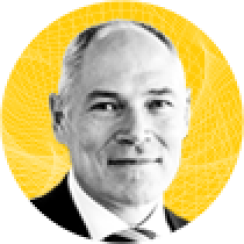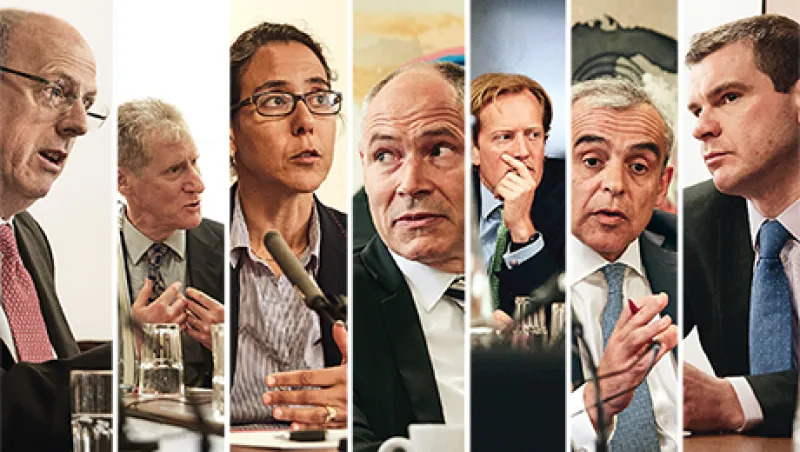European investors must be wondering if business will ever get back to normal. Since the global financial crisis hit nearly eight years ago, they have been buffeted by economic and political traumas, from banking collapses to the sovereign debt crisis in the European Union’s periphery to the backlash against immigration to the scourge of negative interest rates.
Then, just when growth was beginning to accelerate and markets were showing signs of stability, British citizens sent a fresh shock wave by voting in a June referendum to leave the EU. It was the biggest political event of the year in developed economies, and financial markets got it terribly wrong, notwithstanding opinion polls suggesting a very close outcome.
“Until very recently, the volatility in the market was sending a message of complacency,” says Pascal Blanqué, CIO of €987 billion ($1.1 trillion) French investment manager Amundi. “You could have argued that markets were priced for perfection. Many investors were not that protected against the spike in volatility we’ve seen recently.”
Blanqué spoke a few days before the actual referendum. He joined six other elite investors at Institutional Investor’s European Investor Roundtable, held to coincide with our second annual European Investment Management Awards dinner, in London. Blanqué, winner of our Manager Lifetime Achievement Award, was joined by Roger Gray, CIO of the £49 billion ($63 billion) Universities Superannuation Scheme (USS) and recipient of our Investor Lifetime Achievement Award.
Also gathered around the table were Henrik Olejasz Larsen, CIO of Denmark’s Sampension; Mark Lyon, head of investment for the East Riding Pension Fund, a U.K. local authority plan; Tony Broccardo, CIO of Barclays UK Retirement Fund; Salwa Boussoukaya-Nasr, CIO of the Fonds de Réserve pour les Retraites, a French state pension reserve fund; and Alexander Baring, a partner at TCI Fund Management.
All of the roundtable participants were honored for their achievements. And all of this high-powered group, who collectively oversee nearly $1.3 trillion in assets, agreed that their job isn’t getting any easier. Slow growth, low or negative interest rates and continued political uncertainty have diminished return expectations substantially. In a nearly two-hour discussion (and later e-mail exchanges about the aftermath of the British referendum), they shared their views on the market outlook and their strategies for generating returns and controlling risks with Editor Michael Peltz and International Editor Tom Buerkle.
Meet the Panelists Click below to view profiles.

| Tony Broccardo CIO, Barclays UK Retirement Fund |

| Roger Gray CIO, Universities Superannuation Scheme |

| Salwa Boussoukaya-Nasr CIO, Fonds de RÉserve pour les retraites |

| Henrik Olejasz Larsen CIO, Sampension |

| Alexander Baring Partner, TCI Fund Management |

| Pascal Blanqué CIO, Amundi |

| Mark Lyon Head of Investment, East Riding Pension Fund |
Institutional Investor: Does anyone see an end to this climate of ever-more-negative rates and ever-more-volatile and lower returns?
Henrik Olejasz Larsen: I’m sure there will be an end, but it’s certainly not something that we can see from where we are now, because it seems as though central banks all over the world are competing to keep interest rates as low as possible, and in doing that they keep their currencies weak. That’s an impossible thing for everybody to achieve. What is worrying is they’re skewing relative prices.
Take the quantitative easing in Europe, where the European Central Bank is now buying not only a substantial part of low-risk bonds but also moving into corporate bonds and thus twisting relative prices — and making us move into uncharted territories: into less liquid assets, alternative assets and other things that on a relative basis look attractive but which would otherwise probably not have been a substantial part of our portfolio, certainly not as substantial as it’s going to be over the coming years. We cannot see the end of this process yet.
Roger Gray: It is very striking and surprising that several years after the global financial crisis, we are still here, stuck at zero or negative, which we probably hadn’t even contemplated would be the case for nominal rates. But the thing that is strangest is the duration for which that abnormality is now projected in markets to persist. It’s not just the case that for 30 years the U.K. index–linked gilt yield is minus 1, but it’s minus 1.20 for 50 years. So saying that rates are priced to be negative to that extent — and in the nominal markets seeing Bund yields at half a percent for 30 years or thereabouts and Japanese yields at about a quarter of a percent — if the bond market is right, this is a Great Depression that we have ahead of us.
Tony Broccardo: One of the things that a lot of people were talking about was just lack of demand. Lack of demand for loans; a lack of risk appetite within corporates for all the projects that they might have thought they wanted to do in the past. The thought six years ago was that maybe in the fullness of time corporates would retrieve that risk appetite. I think one of the surprising things, given the length of this cycle, has been the continued lack of demand and lack of confidence in the corporate sector.
The other thing, I guess, is the kind of textbook approach of what policymakers have done: trying to encourage savers to take more risk in the absence of demand elsewhere and providing some relief to debtholders. So, if you like, a transfer from savers to debtholders. That’s gone on — and may go on — for a lot longer than expected, which then segues into the generational transfer story. If that’s what is knowingly or unknowingly going on, it will take a long time to extract from this generation to provide some stimulus for the next generation. There’s enough of a story there to think that we are not at the end of the process. We’re at the middle or somewhere around that.
Has everyone formally incorporated this into their return targets?
Salwa Boussoukaya-Nasr: Year after year we have to lower and lower expected returns for the next ten and 15 years. If you look at the ECB, its action has many side effects. The first effect is that it deters government from taking the right steps to improve the situation. They are encouraged to borrow at very, very low rates, so why would they stop doing that? On the other hand, with negative yields, some of the players have difficulties, like the banks for the moment, and we may have another crisis ahead of us. So we have to take into account that it will last for a while and that returns will be lower and volatility will be higher because there is misallocation of capital. Savers are encouraged to take risk, but are they willing to take risk? We do that for our portfolio. We go up the credit curve because we need to have more return. But at some point, there may be too much risk, and if the volatility is there, it may be something that can get out of control.
Pascal Blanqué: I believe the combination of a savings glut, QE [quantitative easing] glut and some features of secular stagnation will stay with us longer than we expect. The next step is probably to see an increase in the temptation to monetize directly budget deficits or something like that. There is a paradox because most so-called strategic asset allocations have hardly changed. We’re still biased toward core governmental bonds, which means that the probability to preserve capital, taking a five to ten years’ view, for an insurer or pension fund has fallen off the cliff or been severely diminished.
I don’t think that people have adjusted to the diminished return environment. If you take a 50-50 equity-bond portfolio, over a century it has returned about 8 percent in nominal terms before fees and taxes. Moving forward, on a trend basis it will return something like 4.5 percent at best. This is a challenging thing for investment.
Is there a contrarian here, anyone who thinks that reflation and normalization are going to take place any time soon?
Larsen: I wouldn’t rule it out. Not soon, but in the United States not only is unemployment low, wages are also increasing. We haven’t really seen much of that in Northern Europe, but as unemployment stays low for some time, it would be unthinkable that we would not feel such a pressure as well.
You say we have not really seen our allocation take into account that we have low rates, and perhaps they’ll remain low for longer. It could even be worse if we see long-term rates increase and we look at a situation of capital losses on long interest rates for some time.
Blanqué: Short term, higher rates are bad news, but taking a medium- to long-term view, normalization could be positive for portfolios. But I do not think it will happen.
Larsen: That’s probably true, but the composition of assets should take into account the kind of monetary policies that we have. To increase risk just because you’re underwater is typically a bad strategy. But to change the asset composition in light of artificially low nominal interest rates, where large participants like central banks buy up certain assets and inflate their prices, is right. That should make you avoid buying the same type of assets. And that should make you more prone to take other types of risks, like less liquid assets. Or go into more stocks. I think it’s remarkable that we have a dividend yield on European stocks of 3.5 percent when nominal interest rates are zero.
Broccardo: It feels that a lot of work has been done by large investors around diversification. The whole move from a purely asset-class thought process to what is commonly called risk premium processes, and understanding how those risk premiums built up, that’s become quite standard now. Personally, I think that has been a positive thing. So there is a hope that portfolios are a little bit more resistant. That if there is a reflationary tendency out there, a lot of funds would hope they’ve got some protection against that. When you look at the history of bad inflation outcomes, generally they’re bucketed in the policy mistake drawer. Given the intervention in markets by policymakers, one’s got to believe that there is a heightened risk of that. Just look at the situation now: the interaction between policymaker statements and market feedback leading to this ebbing and flowing of expectations around the next rate rise in the U.S. We could be living with that for the next five years. And maybe in five years’ time, some significant milestones have been missed and we’re in a reflationary environment.
Blanqué: There is a powerful shift at work across the institutional community from an asset-class approach to a factor-based approach. We’re also seeing a shift away from the classical distinction between a return-seeking portfolio and a liability-matching portfolio, and instead trying to find what I call crossover types of assets, typically with equitylike returns and bond features. The classical boundaries are going away progressively, including the passive versus active distinction.
Broccardo: You think that’s a sideshow now?
Blanqué: I think it’s irrelevant to an extent because on the one hand you’ve got the frontal attack from smart beta on cap-weighted indices. On the other hand, you’ve got the frontal attack by factor investing in the alpha space. I take the bet that in three years’ time we will be defining alpha as what is coming on top of a systematic replication of some factors.
Broccardo: The good news about that development is that investors increasingly don’t need to say, “I’m active or passive.” That was a philosophical divide many years ago. Today it’s okay to blend both. I think that’s where the wedge, if you like, between pure active and passive has been bridged by smart beta. You don’t have to buy smart beta and not believe in alpha; you can blend the two. I think that’s a good innovation because, to my mind, those are what I would call second-tier decisions. Whereas in this environment it feels you’ve got to go back up to those primary decisions, the bigger allocation decisions.
Blanqué: For me the relevant distinction is between what and how: What do I want to do? How can I implement it — cap-weighted indices, smart beta, factors, et cetera, and not active-passive. I think if you are embracing the factor investing framework, basically everything is active in the sense that, consciously or unconsciously, all your buckets are incorporating some factor exposure. The minimum is to know the factors you are exposed to, and the best is to be able to select them, diversify and time them, which is arguably one of the next frontiers.
Broccardo: The biggest marketing budgets across the asset management space are in smart beta. The hope is it’s not procyclical and that it doesn’t blow up and distort markets itself. You see strategy after strategy being arbitraged away. A weight-of-money momentum can drive things to excess. It’s certainly one of those things to look out for.
Larsen: I would like to speak a little bit in defense of cap-weighted indices. I think that there could potentially be something in factor exposures, but a very good reference point is to take the market-cap-weighted indices as a reference, because you can have an informational advantage and utilize that but you cannot have that in the aggregate. The total market must be held by investors. So if there are factors there that can give you a systematic risk premium that will benefit your portfolio, it must be because you are different from some other investors, who are willing to forgo some return because they do not like to have small caps or they do not like to have value companies. It’s a very good reference point for investors like us to think about what is your comparative advantage to other types of investors out there and then reap those advantages of being long-term investors or whatever that is.
Roger, you’ve adopted a reference portfolio approach. Can you talk a little bit about the rationale behind that and what it’s allowing you to do?
Gray: That has increased the investment team’s flexibility. Much of the conversation today is, “What do you do?” Central banks are not looking to make money on quantitative easing. They want to get yields as low as they can possibly be to stimulate the economy, and when they are successful, they will lose a lot of money. There’s quite a lot of distortions introduced. The reference portfolio gives us a lot of flexibility to buy “anything, anywhere,” as we say, to meet the fund’s objectives. We’re focusing more on asset-liability risk and less on tracking error to indices or markets that may not actually be a very good guide to long-term risk and return.
We’re on a mission to upgrade our equity research and concentrate our portfolio. We’re sort of heading from 300 companies in developed equities to about 120 companies. I think our portfolio has the capacity to generate more alpha. We have been at work for almost ten years now building up our private markets capability, and certainly we found niches where we believe we have an informational advantage, where we can reap a complexity, illiquidity or other premium if we can understand it.
We’ve been working hard — this is a very, very demanding task — to try to be able to look at the whole portfolio, including assets that are not regularly priced. We’re allowed to have risk similar to or less than this reference portfolio, which we’re charged with beating over five-year periods. So we don’t have to be too fixated on the short term. And having the capability and the governance flexibility to take timely decisions, that has been what we’ve been doing. And so far, I’m pleased to say that it does appear to be working. All assessments of performance are highly conditional on the period over which you look, but certainly over the past several years we’ve generated a lot of added value from activities that have been quite significantly transformed from how they would have been conducted a decade ago.
Are others adopting this idea of making fewer but higher-conviction bets?
Mark Lyon: Certainly. If you’re paying for active, you want proper active. You don’t want quasitracker or enhanced tracker or anything like that. I much prefer both our internal and our external managers to have high-conviction portfolios within certain risk parameters. In our European portfolio we tend to have about 40 to 50 stocks. In the U.K., because we have a much bigger portfolio, we tend to go around the 80 to 90 stock level.
Alexander Baring: Obviously, we run very concentrated, so ten to 15 positions on the long side. We have conversations about macro, but we don’t really change our portfolio that much in terms of macro. There are very significant disinflationary pressures and some pockets of inflation and productivity growth, and we hope that we’re able to find stocks that participate in that inflation and productivity growth. That’s how we construct a portfolio of ten to 15 names that hopefully are very good businesses. To the extent that we get elements of the analysis wrong, at least we’re stuck with a good company that will be okay in a range of reasonable macro environments.
Broccardo: Like USS, we run the entire portfolio, but there’s a lot that we outsource to specialists. Frankly, our most important competitive advantage is being at the center of the fund. We should know what our targets are and what we need better than anyone outside, and therefore we should understand what types of investments, what type of strategies, will help us hit those targets.
We tend to focus mainly on the bigger picture — macro, the asset allocations, lots of hedging and overlays of managers. And with our underlying partner specialists, we try to give them as much flexibility as possible. So, for instance, within equities we will use derivatives to get exposure to markets. We will use smart betas to get exposure to markets. And we’ll use active managers.
But even on top of those active managers, we’ll put a portable-alpha overlay on top so that the managers could be anywhere in the world, hunting for ideas in what they perceive to be the best places, but then we can control the country allocation. We do the same thing with hedge funds, or, as we describe it, the other-diversifying-assets part of the portfolio. We felt that there is skill in that sector, and there are incredibly talented people out there with fantastic processes, but there was a tendency for some of those strategies to have too much correlation with equity and credit. So we retired some of those funds. We have an allocation that’s based on more macro and relative-value strategies.
Salwa, you have to use external managers. What are you doing differently to get what you need out of them?
Boussoukaya-Nasr: The first question is what you run as active management and what you run as passive. We tend to run passively all the big markets where opportunities may be very difficult to capture. From experience we found the alpha there is too small to compensate for the fees we pay. In the end it’s not worth it.
So we have passive management and we diversified a lot with smart beta. We started with individual smart beta, like minimum volatility or raw fundamental indices. And we had mixed experience because it’s very cyclical, so the approach we have now is to mix them together and to make a combination of several different kinds of smart betas. It diminishes really nicely the cyclicality of the alpha. We’ve increased over time this part of our portfolio, so it’s now around 30 percent of the total of passive management.
Is everyone still willing to take on more liquidity risk?
Broccardo: To invest a plan and to have an appropriate amount of liquidity premium, an investor has to have an implementation facility that is part of the investment process. You have to understand the regulatory environment around balance sheets, around providers of liquidity in the marketplace and how that’s changed; to understand buffers; to manage liquidity positions and counterparty risks. All of that is becoming a central function, particularly for funds that are using both physical and derivative exposures. If you don’t have that implementation capability, you can’t make the investments.
To some extent, that historically has favored the bigger funds because they should have enough resources to be able to build those processes effectively. But I think there’s going to be more requirements to spend more money for large buy-side funds on those implementation skills.
Lyon: There is a significant illiquidity premium. There certainly has been for the past three to five years. So I think if you are comfortable taking that risk, you’re being paid very well for doing that.
Boussoukaya-Nasr: But the premium is shrinking.
Baring: Yeah, it’s not as big as it was.
Boussoukaya-Nasr: In some markets there may be no more illiquidity premium.
Blanqué: The problem I have is that you’ve got two sides to this equation. In the fund industry, in my view, there is clearly an underestimation of the risks attached to liquidity. On the other hand, in the long-term-investment community there is too much focus on daily liquidity, and on daily liquidity of assets in the bond space and not enough on really illiquid assets. So the question “To what extent do I need liquidity?” is not precisely answered by all institutions.
Broccardo: That’s an excellent point because we’re all in the market facing the same pricing, but we have different benchmarks and targets. A retail fund has very different and very difficult-to-predict cash flow requirements. A pension fund should hopefully have more-predictable cash flow requirements, at least in the relatively short term.
I think one of the interesting developments over the past few years has been this move from a barbell — liability-driven investments on this side, return assets on this side — to a greater focus on cash flows. Finding the assets with the cash flows. They’re all different cash flows. They’ve got different layers of cyclicality, and they’ve got different durations. But trying to create those portfolios that will generate those cash flows — that’s driving prices, particularly in auctioned markets, to levels which in some cases just look very uneconomic.
Can you cite an example?
Broccardo: Well, I would say in some of the infrastructure assets out there. I think the Americans call it the winner’s curse. Depends on what gap in a portfolio someone’s trying to fill and what price at the margin they’re prepared to pay, but some of those valuations look very rich.
Larsen: With less liquid markets prices do not necessarily reflect what you really want to have reflected. They may even not be very well defined because if you are a large player, you cannot transact at those prices. So in some sense they are irrelevant. But nevertheless, they are used for purposes that determine how you act, and I think that is a challenge, which means that at least institutions like my own pension fund must change their liability structure and how we communicate returns to our members.
The first step is to move away from formal guarantees where you have solvency requirements based on market prices, because that regime will force you to reduce risk when you have market turmoil. That’s the worst value destroyer that there can be. So we’ll find another scheme. There we have a communication problem. If we are unguaranteed and market values fluctuate, how can we communicate that to our members and convince them and regulators that we are conducting a prudent investment policy? I think that’s very difficult, but the only way to solve that problem is to be more clear on your investment strategies and, from the outset, make clear to our pensioners what they can expect from the behavior of our portfolio in the short term. For instance, that public equity may fall 50 percent or that they may be stuck with some illiquid infrastructure investment that has no price.
What would it take to actually lengthen the investment horizon? Is that even a possibility?
Gray: All of our investment performance–linked incentives are related to five-year performance. And it’s actually five years backwards for bonuses and five years forwards for long-term incentive awards. I think that’s important. Of course, we have data available now. I can tell you pretty accurately how our portfolio performed up till the end of May. And I have noticed that sometimes the fact that we actually do monitor that is interpreted by even some members of our own team as, “Oh, they care about our short-term results.” But actually, what we really care about is the credibility of the future results. I don’t really care about the past results at all. There’s nothing I can do about it, right? It’s prospective ones over a medium term particularly that drive what we do.
Lyon: You have to get trustees to not focus on short-term performance measures because if the data’s available, they want to see it. So there will be a reeducation needed; although you don’t ignore the short term, you don’t really need to focus on it in detail. You look at a three- to five- to ten-year time horizon. That is quite a different mind-set to get your trustees into, I think.
Blanqué: One example, actually, taking the example of the ESG [environmental, social responsibility and corporate governance] space, is an evolution in the institutional community. This idea that there was a trade-off between the philosophical commitment and the financial component — this idea is behind us, in my view. ESG has got to be seen as a pool of risk factors: poorly remunerated, idiosyncratic, asymmetrically distributed across corporates. Carbon is one of them, and there are many others. Some of those risks have a high enough probability of materializing for a long-term investor to take action. But there is always some difficulty when reporting to the board about the trade-off. What if committing to this I lose money?
In order to reassure people to go into those strategies, one answer is to come to them with a sort of free option — basically, screening the portfolio: reducing the carbon footprint, for example, and at the same time constraining the tracking error so that if there is a repricing, you outperform. If there is no repricing, you still get the performance of the underlying cap-weighted index. This is our experience with AP4 in Sweden. They were pretty convinced that being a long-term investor, they were faced with a real risk and a financial cost. At the same time, they wanted to have sort of a free option in case that the repricing comes.
At TCI, Chris Hohn has been vocal on some of these issues, including climate change. Do you factor that in when you look at the companies either in your portfolio or as potential investments?
Baring: There’s always been a contradiction between what the [Children’s Investment Fund] Foundation does and what the fund does. The fund is explicitly about making returns, and clearly on the foundation side it is on charitable work. He’s been very focused on climate change and projects for children in Africa and India. But there have been explicit contradictions. We have in the past had tobacco exposure. We’ve had coal investments, which we’ve pulled back from.
So the investment style of the portfolio hasn’t been guided really on that basis — maybe steered away from some of the fringes of it, but there’s no real overlay of climate change in our investment style.
Do you see going forward that these ESG factors could be more relevant to what you’re doing?
Baring: To the extent that you see the economic relevance of them in the businesses you invest, you clearly adapt your style. Across the auto sector there is a very substantial change as the price of batteries drops to a disruptive level for the traditional combustion engine. The combustion engine probably is in the tail end of its life cycle.
We certainly see elements of these coming into our investment style, but we see the economic case over the next five to ten years, and we’ll have to adapt to that. We apply our own common sense to what will have economic and noneconomic concerns. And increasingly, changes in the climate are driving changes in technology, which are very pertinent. But we don’t filter from a matrix of ESG. We’re not taking a principle view and then trying to fit our investments around that.
Broccardo: Our approach continues to evolve. And I think what we felt about a year ago is we couldn’t have this conversation as a fund in isolation, so that’s why we thought about how we could get a better understanding of what other people think. For that reason we signed up to the U.N. Principles for Responsible Investment. I think we were the first bank pension scheme in the U.K. to do that. What that helps us do is engage with other investors across the world who come from different perspectives, as we try to continue to evolve our process.
Gray: Obviously, TCI has a reputation for doing activism, and we do take strong positions on governance. Often we see our biggest opportunities in investments where there are significantly negative governance overlays. It’s where we have found ourselves to be successful, and we’ve had times when we’re not, but where we’ve found ourselves to be successful is you find great businesses with significant governance problems and you hope you can be a catalyst for the change of governance.
How many people here have specific ESG allocations?
Lyon: It informs part of the investment process, but we don’t have a specific allocation to ESG, and it’s unlikely that we’ll ever go down the route of divestment on a theme or anything like that. We just treat everything on a stand-alone basis as part of the investment process.
Boussoukaya-Nasr: We do, but you have to see our ESG policy as a triangle. Because we have broad-based principles around all the investments, like voting, like the U.N. principles and companies we don’t want to invest in. And then on top of that, we can have the different layers, like reducing the carbon footprint. We are thinking about the coal industry at the moment. And on top of that, we ask our managers to look at ESG principles when they invest, but they are not specifically designated as an ESG mandate. We also have a layer with ESG driving the choice of the investments with very concentrated portfolios.
I think the problem with ESG is it’s like a leap of faith. Nothing has been proven that companies with the best ESG rating are outperforming the others. You really have to be very, very confident that at some time it will deliver. Just like when you hire an active manager with a high tracking error and a very concentrated portfolio. It may underperform for a period of time. You have to understand why and to believe that the process is sound and that at some point it will create more value than the current underperformance.
Larsen: We don’t currently think of ESG as something that is performance-enhancing. It’s something that we have as a part of our implementation strategy to be able to face our members and we think we can implement these strategies without hampering returns. But that it actually could be a performance-improving strategy I think is very doubtful. Maybe in the short term, when such an investment strategy attracts a lot of institutional demand, then it may be self-fulfilling.
If you could do only one thing for the rest of this year, what would that one thing be?
Larsen: What really is driving a lot of what we do is to do things more directly internally with a view to get low-cost access to low-risk assets that are more complicated, less liquid and so on but are a better alternative than buying government bonds with negative interest rates. That’s a theme of many things that we do.
Gray: I would say better understanding long-term-investment opportunity and risk, and factoring that into the portfolio strategy and the oversight process. The metrics of risk analysis are really volatility- and VaR-centric, which are cousins, but for some of the reasons we discussed today, they may be quite distant cousins from the long-term risk skew that you might have in a particular portfolio strategy.
Broccardo: The thing for us is to complete the rebuild of our team. We’re attracting much more interest internally. We have a corporate sponsor. We have a lot of very talented technical specialists, and those specialists are finding they can apply their skills to help us solve the investment problem ourselves.
Lyon: We’re in the middle of a government-led reform process, which is requiring the local authorities to pool assets. So rather than having 89 individual funds, there will be anywhere between six to eight pools of £25 billion to £35 billion, which enables us to maybe do something differently with that scale advantage. It’s being led by government in order to reduce fees. We see that as a positive. But if we can do something a bit differently, a bit more direct — more co-investment with managers, particularly on the alternative side, because we are going to probably gravitate more toward alternatives — I think it’s an opportunity. But we’ve got to be aware of the risks of that as well.
What impact will the Brexit referendum have on markets and your portfolios?
Lyon: There will clearly be a period of political and economic uncertainty in the U.K. and Europe in the short term. Following a sharp correction in the aftermath of the referendum, financial markets have generally recovered, possibly due to the realization that divorce proceedings are likely to take some time and the expectation of further monetary easing. As is often the case in crises, the currency has taken the brunt of the correction, with sterling depreciating by around 10 percent, which actually has a positive impact on a sterling investor’s overseas investments. As a long-term fundamental investor, the pension fund is unlikely to make any material changes to its asset allocation in the short term.
Larsen: We have seen an increase in the risk premia required in financial as well as real investments. This will be a temporary drag on growth, but we do not see this as having any substantial negative impact on growth outside the U.K. We will be more conservative on real investments in the U.K. That goes both for investments like infrastructure that rely on stable political support and public finances, as well as investments in commercial real estate that depend on growth in general. For global growth, however, we expect that the effect will be hardly noticeable. Thus we will not reduce overall investment risks but may take advantage of relative mispricing as evaluated against long-term fundamentals.
Blanqué: Uncertainty remains high and we believe it won’t ease any time soon given the complexity of the subjects to be dealt with. However, this is a political crisis, not a financial one. We are not in a revival of 2007–’08. The impact on global growth should be limited, as the main driver remains internal demand. We still believe global growth will be in the region of 3 percent this year and in 2017. The European Union has some challenges ahead, but we are convinced they will be overcome. Remember that Europe is at its best under pressure.
We believe the Fed will not increase rates in the foreseeable future, while the ECB, the Bank of England and the Bank of Japan will increase their interventions. Some interesting entry points will come at some point for long-term investors. We are now in an environment where classical asset allocations will prove inefficient in the future as yields on core govvies go globally deeper into negative territory and can no longer be considered as safe in terms of capital preservation on a short- and medium-term horizon. •






